Sweet baby Jesus this gun is pretty.
Taylor’s & Company has imported a limited run of nickel-plated Smith & Wesson Model 3 Schofield break-top revolvers. The Schofield is one of the iconic guns of the west, with a rich history. It would be hard to do such a storied horseman’s sidearm justice, but in every way, this Italian-made Uberti replica does just that. It is an exceptional revolver.
The Schofield is derivation of the famous Smith & Wesson Model 3. Originally made in 1870, the top-break Model 3 has the distinction of being the first cartridge revolver to become standard issue in the US Army.
Although the United States Army would end up ordering thousands of the guns over time, as would several other countries, it was the Czar of Russia that really got the ball rolling. Starting in 1870, Czar Alexander the II ordered over 40,000 of No. 3 revolvers in different variations.
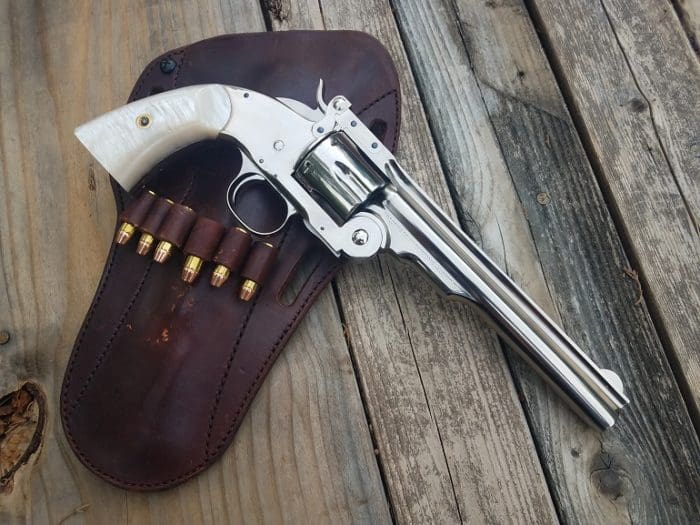
Unfortunately for Smith & Wesson, the Russians loved the design enough that they copied it and refused to pay for most of the orders already made to the czar’s specifications. The result was catastrophic, almost bankrupting Smith & Wesson.
To make matters worse, unlike the czar, the United States infantry was underwhelmed by the Model 3 during its early trials. They preferred the simple design of the Colt Open Top and then the Single Action Army, Model P “Peacemaker.”
Everyone admitted that the S&W was twice as fast to reload as the Colt, and it seemed to be more accurate as well. But infantry commanders argued that the soldiers didn’t use their sidearms much, rarely had need to fire more than six shots, and the Colt’s accuracy was good enough to get the job done.
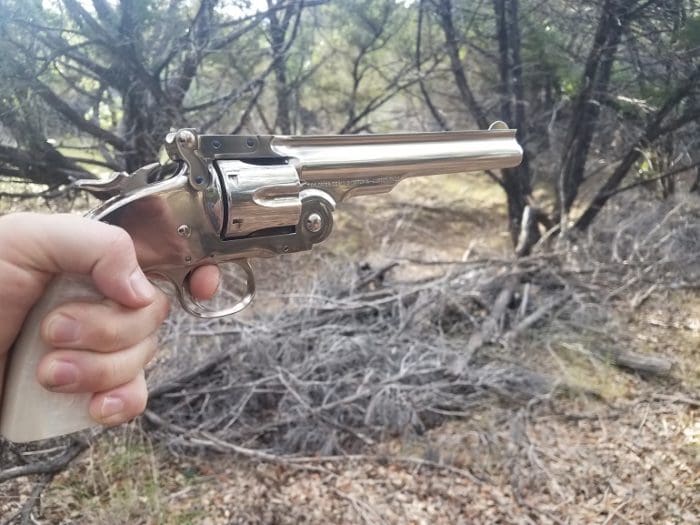
They preferred the Colt partially because it was deemed to be more durable than the Model 3, especially during a pistol whipping. I kid you not. Apparently the Smith & Wesson’s two-piece frame had a tendency to come apart when used as a bludgeon, whereas the Colt remained together…a big win for the Colt. As a former Joe myself, I hate to admit it, but the big army was probably right. Give a Joe something he can break and he will.
It was during its early trials and use by the US Army that then Major George Schofield took an interest in the sidearm. He chose to look at the problem not by walking in an infantryman’s boots, but from the perch of his 10th Calvary saddle. Schofield recognized the value in the Model 3’s break-top, fast ejection design for a cavalryman riding on horseback. He just had a few changes to make.
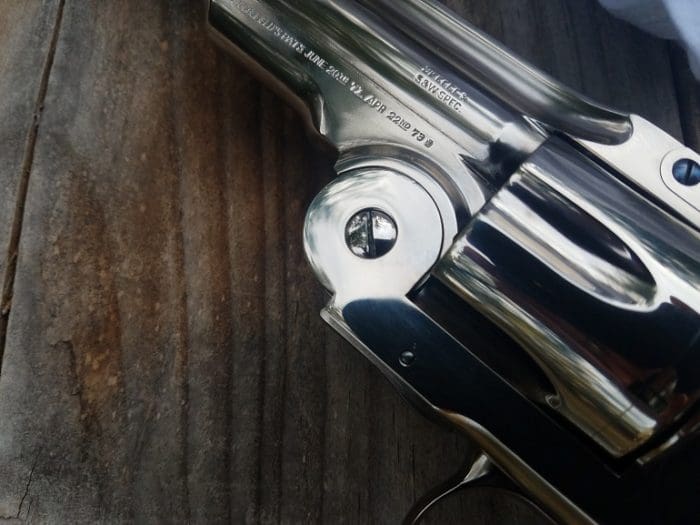
He wrote to Smith & Wesson with his ideas, including moving the barrel latch to the frame, as well as a single-toothed spring and a cam released that snapped the extractor/ejector back down when that tooth made contact with the lower strop. He also suggested making the rear sight integral to the latch.
He was granted patents for these modifications on June 20th, 1871 and April 22, 1873, as all S&W Model 3 “Schofields” after that would be marked until the end of their production.
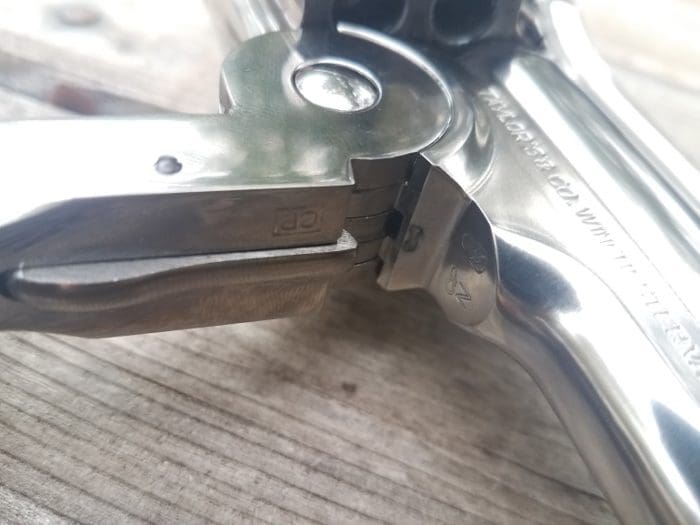
Schofield’s design was a big improvement over the previous Model 3s. In 1875 The military ordered 3,000 of the new Schofields in what would be a relatively short-lived contract and put them in the hands of the 4th, 9th, and 10th cavalry.
Just two years later Smith & Wesson would further refine the Model 3, incorporating Schofield’s designs in their “New Model No. 3” and their variations, the “Frontier” and “Target” models. Although they never became as popular as the Peacemaker, the original and New Model 3 Schofield patented revolvers became a well-known and much desired sidearm of the late 19th century.

The Schofield versions were favored by many famous professional gunslingers on both sides of the law. Jesse James was known to carry two pistols on him, one a Colt and one a Schofield. When Bob Ford shot James in the back, he did so with a Schofield. Sherriff Pat Garret, the man who killed Billy the Kid was known to carry and use the Schofield patented pistol, as was Texas outlaw John Wesley Hardin and even President Theodore Roosevelt.
The Model 3 was used throughout the American West, as well as in several American wars, all the way up into the 20th century. Its clockwork action, accuracy, and speed became icons of the era. It was one of the foundational models of the Smith & Wesson enterprise, even though it was never much of financial success.
I could write more than I have time for about Lt. Colonel George Schofield himself, as well as the fortuitous arrangement he had with his brother, who headed up the Army Ordnance Board.
By all accounts, George Schofield was a frenetic inventor, and likely suffered from significant manic depression. Sadly, he ended his life with one of his own revolvers. His obituary, dated December 17, 1882 in the New York Herald stated that “he had been crazed for eight or ten days over some invention of his, and it is supposed that in a moment of temporary insanity he shot himself.”

Taylor’s & Company sells several versions of the S&W Model 3, including a few Schofields. This one is a definite up-class version, not just working well, but looking incredibly good too.
The entire revolver is nickel finished and mirror polished. Be careful when shooting this gun in bright sunlight, as its reflection may blind pilots in low-flying aircraft. The finish is perfect throughout the gun, down to the tiniest parts. Beyond the even and smoothly polished nickel, take a look at the screws.
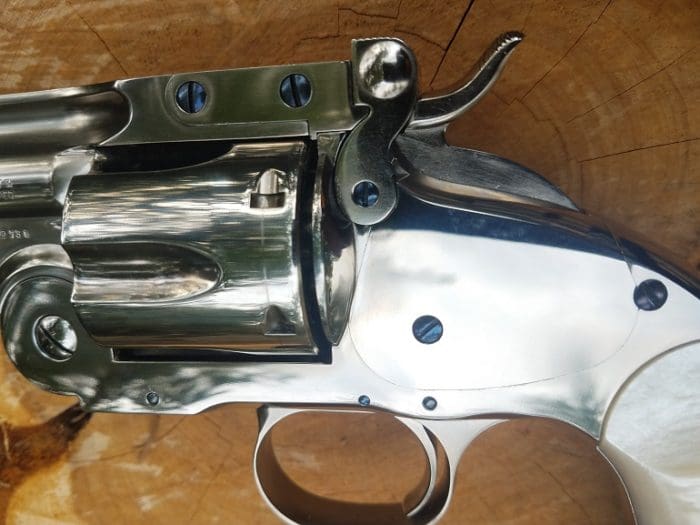
All of the screws on the frame are colored a beautiful blue. They contrast and set off the mirrored nickel well, and add even more class to a gun with a lot of attention to detail. By the way, most of the these photos were taken after the first 100 shots, and the gun was only wiped down with my T-shirt. You should have seen it out of the box!
Nickel plating can be pretty and durable, or pretty and easily chipped. I can safely say this one is very much on the durable side.
I shot the heck of the gun, shooting the first 100 rounds — all my own hand loads — in about three hours time and it got dirty. I tried it out in a few different holsters, doing my best to figure out how to quickly draw a seven-inch barrel gun. (It turns out, I can’t.) I also played with the latch, releasing it and flipping it back up probably a couple hundred more times.
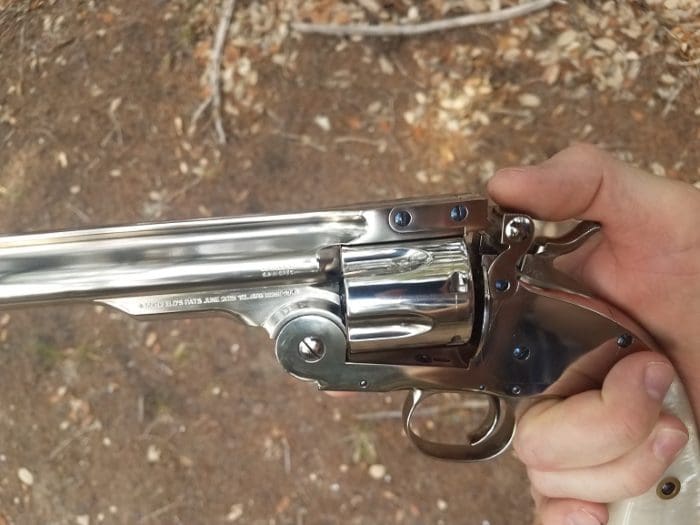
There are two “cocked” positions for the Schofield. The first slightly cocked position is how it was designed to be carried. This both removed the integral firing pin attached to the hammer from the top of the primer and also allows the shooter to pull back on the release latch integral to the rear sight.
Upon release, the muzzle swings down, and the extractor comes up, pushing all of the cases up. A little more force and the barrel tips back at the shooter, the cylinder comes forward, and all of the cases fly out in front of the shooter.
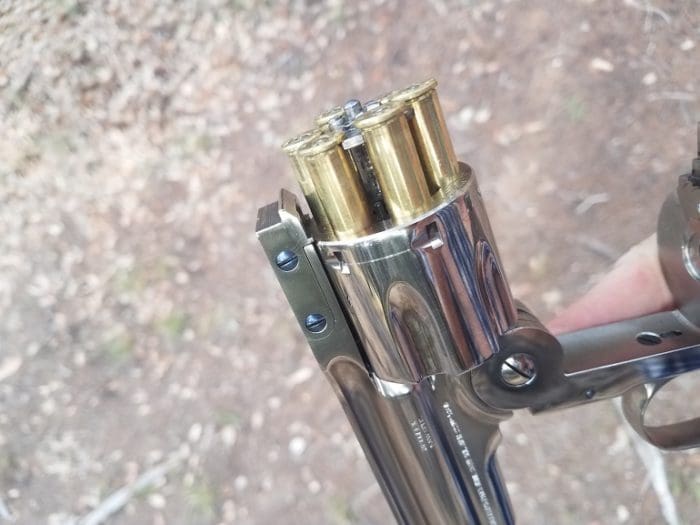
Some claim that the revolver can then be reloaded again entirely with just one hand although I certainly can’t figure out how, especially on horseback. Once new cartridges are inserted, a quick flick of the wrist sends the muzzle up and the cylinder back down, locking it back in place. The gun is ready to fire again.
That whole sequence is fascinating to watch, and I did it over and over, even with empty cases, just to watch them fly out of the chamber again. It’s just fun.
The upside to you, dear reader, is the knowledge that even after the shooting and drawing and just tons of goofing around, there’s still no obvious wear on the gun.
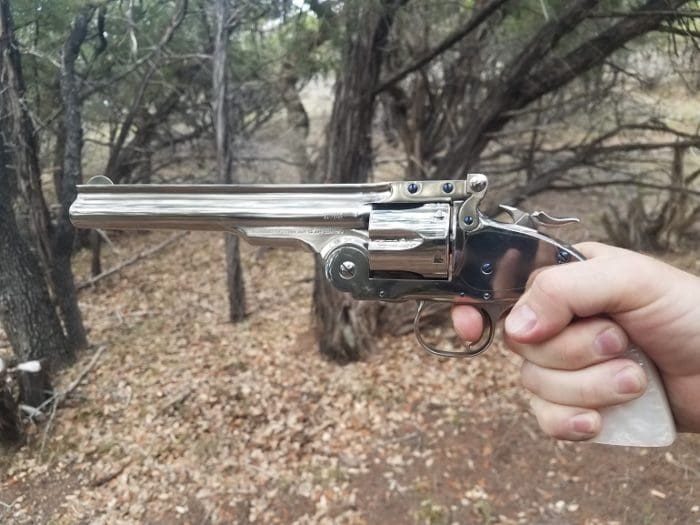
Ah, but is it authentic? Did shooters in the latter part of the 19th century really like a nickel finish on their guns? Yes, they absolutely did, and they could get them straight from the factory. In fact, starting as early as 1860, any revolver could be ordered from Smith & Wesson with either a blued finish or nickel-plated.
Almost all of the early No. 3s marked “Schofield’s patents…” went to the US Army for use by the cavalry. As these guns hit the surplus market, they began to be picked up by everyday civilians, law enforcement, and companies alike.
They became very popular with the US marshals, as well as Wells Fargo. Believe it or not, before they were a bank repeatedly fined for unethical conduct and defrauding account holders, Wells Fargo was pretty well-respected. Their investigators were, in particular, seen as the professional gunslingers of the day. They were the “operators” of 1890. As a company, they chose the Schofield as their sidearm of choice, buying hundreds of the revolvers and shortening the barrel of many of them down to five inches for ease of concealment and carry.
Not long after, much of the public did the same thing, having their barrels modified from the cavalry’s original seven inches down to five. Some took the extra step of nickel plating them as well, just like some of the “operators” did. The more things change, the more they stay the same.
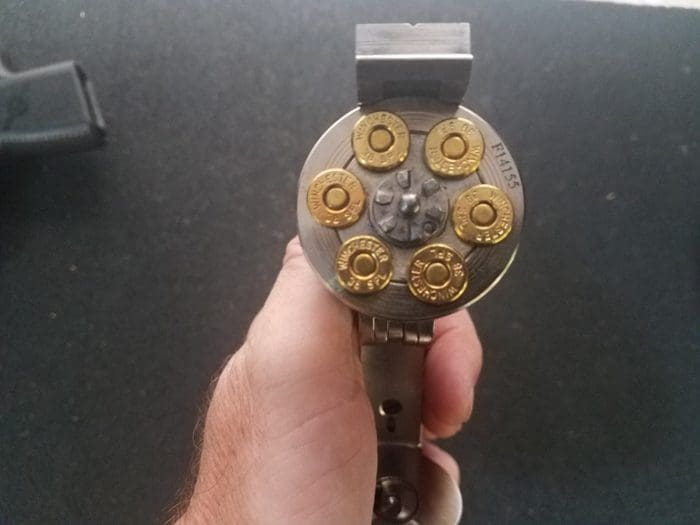
This revolver from Taylor’s & Company is chambered in .38 Special, a cartridge that wasn’t available in the Model 3s from the factory. The first S&W revolvers to be chambered in 38-40 Winchester (similar to the modern-day .40S&W) came out in 1876, but Smith & Wesson didn’t start chambering pistols in .38SPL until 1898.
It’s possible that some of the Schofields in private hands were chambered on custom order in .38-40 Winchester, but I can find no actual examples of that chambering. However, the .38SPL is only one of the chamberings offered by Taylor’s & Company. They also offer models in .44-40 and .45 Colt. The original caliber used by the cavalry was the now practically extinct .45S&W, a black powder cartridge closely duplicating a light-loaded .45ACP.

Although not entirely authentic, the .38SPL is a phenomenal shooter in this gun. There is very little recoil. I had several people fire this revolver, including a new shooter at The Range at Austin, a 9-year-old girl who had never shot a gun in her life. She had no issues at all, other than it was a little heavy for her.
Even with hot .38SPL+P commercial ammunition, muzzle rise is minimal, including shooting single-handed. I would not expect most commercial .45LC to be any different, and only the .44-40 would likely show a real difference in recoil. Even so, with the .44-40 or hot .45LC loads suitable for close range hunting, recoil would be very manageable, even by the inexperienced shooter.
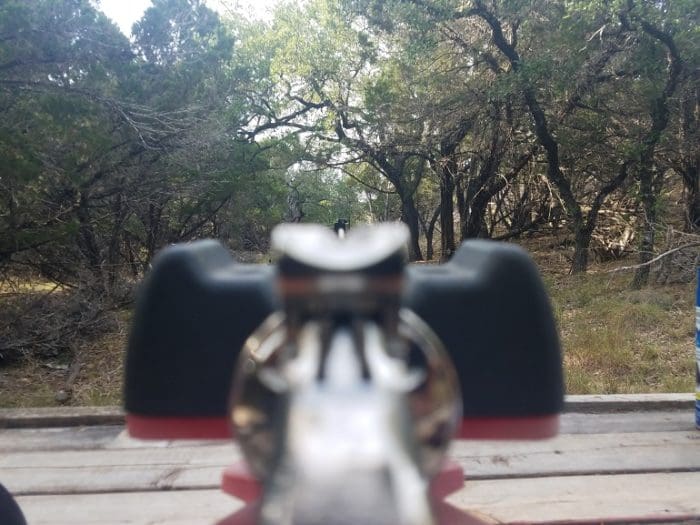
As I had already put more than 100 rounds through the Schofield during a series of drills, I wasn’t surprised that it was a gun capable of considerable precision. I just didn’t realize how precise that really was.
After my second shot at 25 yards using Remington’s 130gr FMJ UMC round on a paper, target I was genuinely confused. I had the gun resting on bags on my shooting bench. My hands were on bags, my arms were on bags, and my chest was leaning in and against the bench. I was still. I had taken my time during the shots, and my sights were on target the entire time.
How, then, did I miss the paper entirely?
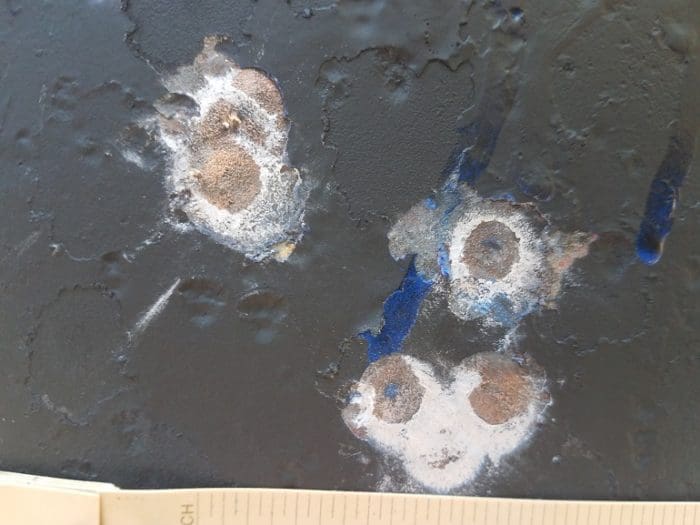
My third shot confirmed what many of you are likely suspecting. A hole in a hole is awful hard to see at 25 yards. Just for visual effect, I moved to shooting steel.
I shot 60 total rounds for accuracy with this pistol. I used commercial rounds from Remington UMC, Winchester 158gr LRN, and Armscor 158gr FMJ rounds. Shooting four rounds of five shots from each manufacturer, not a single one averaged larger than one inch at 25 yards. That lighter weight Remington round scored 3/4″.
I shouldn’t have been particularly surprised, as this is the second Uberti pistol I’ve reviewed, and I’ve bought two others. They’ve all displayed this level of accuracy. Like the others, part of this accuracy comes from good sights, a long sight radius, and a great trigger.

The rear sight is integral to the cylinder release latch. At the top of the simple V notch are deep horizontal grooves and a deep oval cut for your thumb. Way up there behind the muzzle is a simple, thin metal blade front sight.
Between the two, there is plenty of space to see the target, but by aligning the base of the V rear with the front sight, a great deal of precision is possible. For most of my groups, there was relatively little horizontal spread where the rounds would lay.
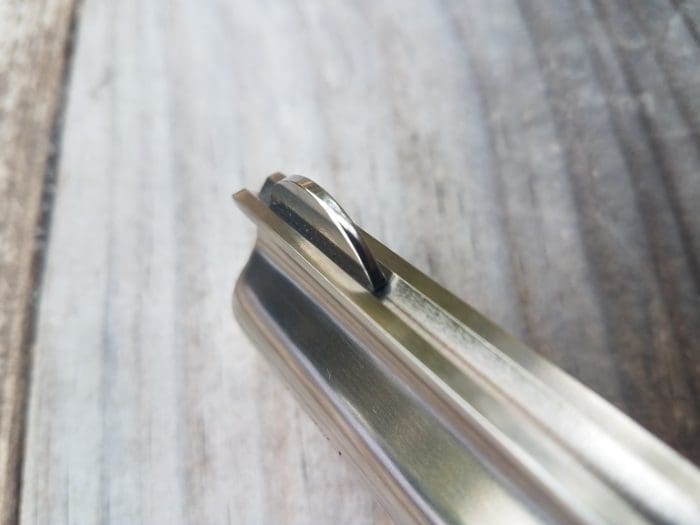
Unfortunately, at 25 yards, they lay about three inches to the left of the target. I had several shooters try the gun, and the results were the same for all of them. The gun shoots nice, tight, consistent groups. They’re just consistently to the left. And the sights aren’t drift adjustable,
I would have guessed the trigger pull weight was about 2.5lbs with no creep and a clean break. It’s actually heavier than that, measuring at 3lbs 10oz. It feels much lighter and there’s no way I would change a thing about it.
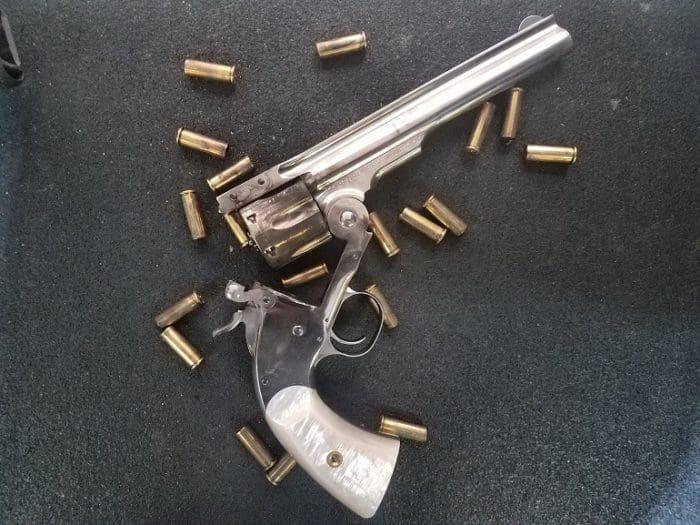
I shot a total of 200 rounds through this revolver for testing. One hundred of those were commercial rounds and 100 were my own hand-loads shooting one a 170gr SWC pushed by 4.2gr of Unique powder. Other than the Unique making the nickel finish filthy, I never had any issues with reliability in any way.
At no time did the gun fail to fire or cycle. With a flick of the wrist, the break-open revolver never failed to eject all cases cleanly. I lubed the gun prior to shooting with EEZOX and performed no other maintenance for the first 100 rounds. Those first 100 were all lead cast rounds, so I fully cleaned the bore after that, prior to shooting the commercial loads and testing for accuracy.
That’s not my usual procedure, but it didn’t seem fair to lead the bore up really good and then test for accuracy with commercial ammunition. As it is, I have zero reservation as to the reliability of this revolver.
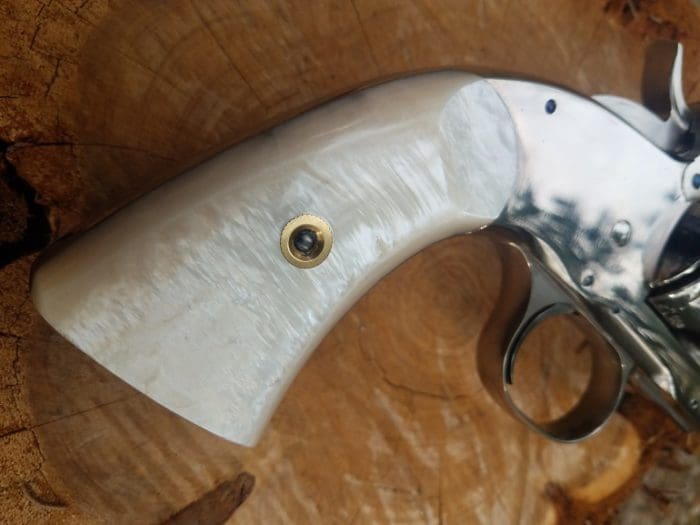
The grips on this short run release are a synthetic resin made to look like mother of pearl. Many folks scoff at such fancy looking grips, thinking they aren’t authentic. Nothing could be farther from the truth.
Long before the Gucci GLOCK, shooters from all walks of life were fancying up their guns, I can find quite a few photos of old revolvers with mother of pearl grips, including ones used in the saddle by working lawmen. This Schofield patented revolver below is particularly embellished, as befitted its owner, Annie Oakley.
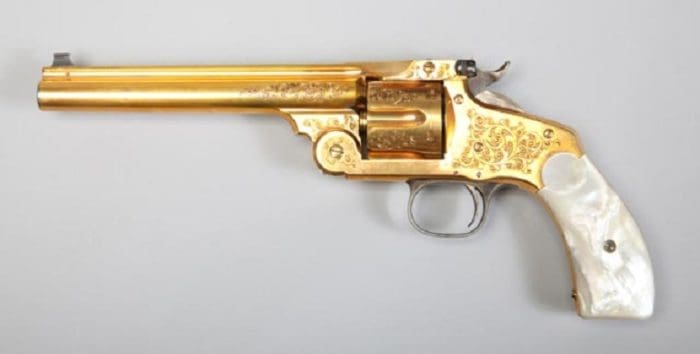
Cavalrymen would have been issued walnut grips on their service revolvers, and these authentic grips are available from Taylor’s & Company as well. The imitation mother of pearls grips on this fancier model are well done and perfectly usable.
I shot this gun in the Texas Hill Country “Spring” heat, ranging from 90 to 102 degrees. Unsurprisingly, my hands were a little sweaty during a few of the courses of fire, and the smooth grips didn’t help. But they didn’t hurt much either, as the tiny amount of recoil exhibited from the three-pound revolver just didn’t move the gun enough to matter.
Despite the heat, I couldn’t help but try my hand at some quick draw and rapid fire single-action shooting. The key word in that last sentence is “try”.
I spent a good amount of time drawing from my Simply Rugged holster and shooting two shots into a 10-inch circle at 15 yards. My better times were around 1.8 seconds. In cowboy action shooting, that time would be good enough to keep me from getting laughed off the range, mostly due to the kind nature of the folks that attend those events.

In my defense, the hammer of the Schofield is a little farther forward than the Peacemaker’s, and the hammer throw is also a little longer, so the Model P is always going to be a little faster. That’s one of the many reasons it’s so popular to this day.
Also, the seven-inch barrel of the Schofield is a whole lot of steel to clear and point before it gets up there in the first place. But mostly, I’m just slow and I always have been. My time to draw and fire six shots into the same 10-inch circle at 15 yards averaged 4.56 seconds. If that sounds bad, well it’s not nearly as discouraging as it is fun.
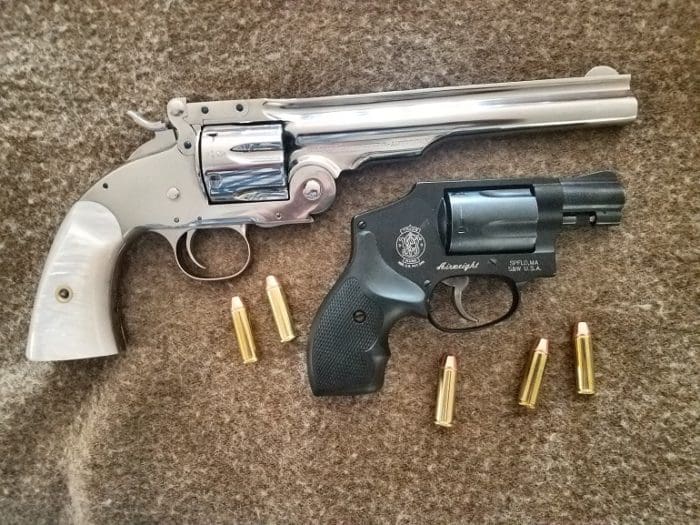
It was hard to give this one back, and I have little doubt I’ll end up picking one up at some point. Likely with the walnut grips and chambered in .45 Colt. The gun is just too accurate, too easy to shoot, and too much fun not to own one.
It’s a great look back into history at one of the competitors of the Colt, and one of the foundations of the Smith & Wesson legend as well. Taylor’s & Company picked a good one.
Specifications – Smith & Wesson Model 3 Schofield
Barrel Length: 3.5″,5″,7″
Caliber: .38SP, .44-40, .45LC
Capacity: 6
Weight: 3.5″=2.85 lbs, 5″=2.90 lbs, 7″=2.97 lbs
Finish: Nickel Finish with charcoal-blue screws
Grip/Stock:2-piece Walnut or Pearl
Manufacturer: Uberti
Sights: Blade Front, Rear sight on back of barrel
Overall Length: 3.5″=9.25″, 5″=10.75″, 7″=12.75″
MSRP: $1,522.00
Ratings (out of five stars):
Style and Appearance * * * * *
Fine as hell, y’all.
Historical Accuracy * * * *
There is a transfer bar for safety, which is a good idea. There also appears to be a slight thickening of the top strap over the original’s, I assume in order to accommodate the larger .45 Colt. Also the grips aren’t real mother of pearl, but imitation. Real mother of pearl grips would add at least $100 to the price of the gun. Beyond that, it appears to be completely accurate, down to every marking and detail. As fancy as this gun looks, many originals were just the same.
Reliability * * * * *
The Smith & Wesson Schofield loaded, unloaded, and fired perfectly every single time, no matter what I put through it.
Accuracy * * * * *
All one-inch groups and many less at 25 yards with cheap commercial ammunition. An exceptional shooter.
Overall * * * *
I really enjoyed this gun, but the sights being slightly off kept it out of my 5-star category. Beyond that, it’s a beautiful, functional, surprisingly accurate revolver. Plus, it’s just fun to shoot.
In writing this article I relied heavily on three sources. The Standard Catalog of Smith & Wesson, Smith & Wesson Handguns and one of my absolute favorites, Age of the Gunfighter.

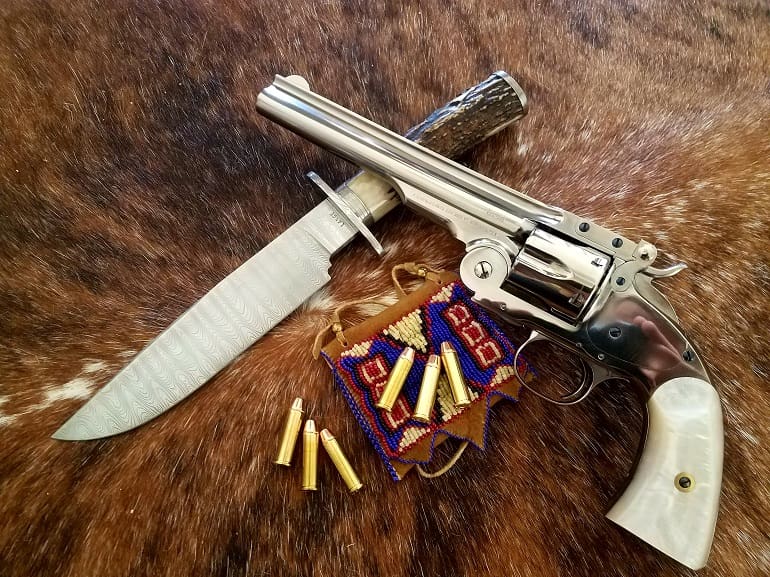



A lady on the Netflix show Godless had one of these that was used in the final gun-slinging match and I drooled over it then. They lady was okay looking too.
Mr. Taylor,
As usual, a top notch review but I feel a bit cheated. Who made the bowie? I look forward to all your submissions.
The late great Donald Lange. I have a collection of American Master Bladesmith bowies, and his is certainly the most beautiful. Incredible work from an absolute master of his craft.
And thanks. Really, the old west guns are by far the most fun to review. They take me a long time just because I end up reading a lot and going down the rabbit hole of history, just to delete most of that stuff from the article anyway.
What’s great about the internet, Google Books, and Amazon is that for not too much money, you can download so many history books and fast. But they rarely agree with each other.
For instance, how many Schofield’s were actually delivered to the army? I can find sources that say 3,000, 3,035, 4,000, 8,000, and 8,035. The only actual order I can find with anything from the Army Ordinance Board is for 3,000, which is in the wrong caliber, and the contract was cancelled just 2 years later. So how many actually got delivered in total? I’d love to find that hand receipt.
Being a Lefty, I really wouldn’t mind seeing a return of the top break revolver to the modern market. It is a truly ambidextrous design.
Unfortunately, “modern” has come to mean “semi automatic” these days…
… ah, we’ll.
🤠
Yup, and the cylinder spins either direction when free, so it’s easy and sure to line up an empty cylinder. (Which you don’t need to do on these modern guns.) It turns clockwise in the action.
Which, for those of us who are revolver fans, is how we like to see cylinders turn: “into the window” or clockwise.
Great review, *super* photos.
Thanks, I really struggle with the photos. I’m just not a visual person. But Dan and RF gave me some good pointers, and I’ve read a lot of online tutorials that have helped. Glad to see it’s paying off. Now if I could just figure out how to keep my hands out of the shots on shiny guns…
Back up and zoom out. And/or use black “reflectors” (matte poster board or foamcore) to help hide them.
But it is tough. Whenever I see a professional head shot poster I look closely in the model’s eyes. Usually can see the photographer and often the lights and reflectors they used. Southwest Airlines has a campaign like this. Kills time standing in the jetway finding the reflections.
“And/or use black “reflectors” (matte poster board or foamcore) to help hide them”
What is the position of these reflectors? Is it behind me or as a backdrop? Really, I’m just clueless about this stuff. I appreciate your suggestions.
You had me right up until the line that starts “MSRP”. Ouch !
I know right? That’s at least 3 ARs, or eleventy dozen Hi-Points.
I think from now on instead of listing the MSRP I should just do it by how many Glocks you could buy with that amount of money.
Look for auctions with plenty of firearms… I went to one in Rome, Georgia where a Doctor was getting a divorce,, Had over 300 firearms and all were new or almost new,,, I bought a Uberti Scholfield 45LC taxes and all for $530.00. I could have probably gotten one in a 38 for $350 but I stopped bidding,,, Lots of folks were after the modern handguns,,, I had to have the star worked on for $60 and it works great,,, Gunsmith is wanting me to put a price on it for him but, I’m hanging on to it for now,, Two months later another auction came with another 350 firearms give or take a few,,,
Might try to convince my wife it’s a necessity for family defense
It’s the only weapon to use on those wayward robots from Westworld…
yeah,..everything’s pretty about that gun….[except the price!]…..
Based on Taylor’s & Co.’s website, the $1,522 MSRP is for the walnut grips. The MSRP for pearl grips is actually $1,859! …and yet I still want one! Fantastic weapon!
That “top break” action just seems to make more sense to me. I wonder why it never became the norm.
Thanky for the review.
They’re not as strong. For low pressure loads they’re fine.
I Wish for a top break big bore short barrel revolver
I like my Webleys
Some years ago I purchased a replica S&W New Frontier #3 top-break revolver in .45 Colt with a blue finish. I agree with you about the handling and shooting qualities of the top-break revolvers – they are just fun! The only thing I did to pimp my revolver was to change out the wooden grips for after-market hard rubber ones. In .45 cal, it bucks a bit when fired, but still very comfortable to shoot. I only shoot smokeless cartridges with this gun. Mike Beliveau (Duelist1954 on YouTube) has a video of him shooting this gun with black powder, if you’re interested.
As to the nickle finish on your test gun, I’ve read that this finish was popular with shooters because it resisted corrosion from shooting black powder cartridges. I might point out that the photo of Annie Oakley’s revolver does not show a #3 Schofield, but rather a #3 New Frontier model – it has a different top latch and grip shape than the Schofield. Otherwise, great review.
Oh, and as far as your attempt to achieve quick-draw with your test Schofield, you should remember that in the Old West, quickness with a gun (like modern quick-draw competitors or the movies) wasn’t considered that important. Bat Masterson, writing about what made the Old Western gunmen so dangerouos, ranked quickness with a gun third, behind deliberation/coolness under pressure (#1) and accuracy (#2). If you are using authentically designed Old West gun leather with your revolver, put a coin on the back of your hand and then go for your gun. If you can get it drawn, pointed and fired by the time the coin hits the ground, you are quick by their standards.
As to replica Old West revolvers, I’m really waiting for somebody to produce a decent replica of the Merwin & Hulbert Army model (3rd variation or later, preferably in stainless or nickle-plate). I’d plunk my money down for one of those in a heartbeat.
A fellow up here in Wyoming was looking into duplicating the M&H revolvers. He found that it could not be done profitably at the price he wanted to put on them.
M&H revolvers are finicky little beasts. Very sweet, but complicated to machine. I’ve thought about it a bit.
There’s a reason why S&W and Ruger are the companies still shipping wheelguns.
I followed the whole M&H replica controversy – especially the part where people had put down deposits (which they never got back) and no revolvers were produced. I later heard that Uberti (in Italy) was considering manufacturing a M&H replica, but nothing came of it. So I’m not expecting to see a decent M&H replica revolver in my lifetime. If somebody decides to go for it and can overcome the complicated machining, I expect that it would cost about $1,500 or more. I have the mad money for it. In case.
I’m half of a mind to make one myself one day – not for production, but just to say I did it. That, and a Luger.
The problem with many of these efforts by people who don’t have experience in gunsmithing/gunmaking to reproduce historic guns is this: they don’t know what they don’t know. Too many think: “Oh, we buy a CNC machine, some CAD/CAM software, a computer, hire a couple of machinists and wha-la! Reproduction gun and profit!”
Wrong. Wrong, wrong, wrong…. so expensively wrong.
One of the big (huge, actually) issues in trying to replicate some of these guns is this: “How the *(&&*(^ do I hold onto the workpiece?” This is a problem which cannot be solved merely with CNC machines and CAD s/w. You have to think as a gunsmith, machinist and businessman all at once. Too many people think in terms of only what the CNC machine can do, and what tooling they can buy. I’ve got a newsflash for people who think this way: If you’re going to make or work on guns, you will have to make tooling for the job. You can buy some gun tooling (eg, from Brownells), but there’s tons of gun tooling a gunmaker or gunsmith has to make, because it cannot be purchased. I have drawers in my roll-arounds filled with widgets and gadgets that I’ve made to do one specific job on one specific make/model of firearm. eg, I have a couple of plastic blocks that I use to hold a 1911 slide upside-down so that I can stake on a new front sight. I have tools used to carve out barrel channels in wood. I have a fixture to hold a 1911 slide in a mill vise at funky angles. I have all manner of widgets for sporterizing a Mauser 98 action, more workholding for a Rem700 style action, tools to hold a bolt in a lathe, and dozens of hand-ground high speed steel cutting tools for the lathe to do a specific job.
Then I went out an purchased the estate of a deceased gunsmith. His heirs had no idea what most of the tooling in the wooden toolboxes was. I, another gunsmith, have figured out only about half of the tools he made – what they were for, etc. There are no instructions, no documentation. Some of them one can figure out immediately – they obviously solve a problem I’ve had or seen. Some of them I’ve figured out by looking them over for a half-hour and memorizing them – and then, one day, I’ll be working on something and I’ll say “Ohhhhhhhhhh…. that’s what he was thinking…”
This is where I relate the cost of producing the Winchester Model 12. The Model 12, as many know, was a very nice pump shotgun – released by Winchester in 1912 through 1914. After Winchester got through proving the design and making about 30 prototypes, when the corporate decision was made to “go for it,” they spent a year tooling up to make the initial Model 12, and another year tooling up for the other gauges. Much of that time was spent making fixtures, jigs and tools to make the Model 12. It cost Winchester the equivalent today of about $14 million dollars and a couple years of calendar time to make this happen. When you consider how much more straightforward it is to make a pump shotgun vs. a revolver… well, now you have an appreciation for why so many of these “rich guy buying a bunch of tools and a dream” schemes don’t (and won’t) work.
Small nit:
I don’t think the screws are color cased. I put screws like that on custom guns, and I do this by nitre blueing.
You take sodium nitrate salts, heat them to about 585F, you drop in the de-greased screws, and wait 15 minutes. Poof, perfect heat blueing.
Here’s the salts from Brownells:
https://www.brownells.com/gunsmith-tools-supplies/metal-prep-coloring/metal-bluing/bluing-salts/nitreblue-bluing-salts-prod1105.aspx
I use a an electric lead pot to heat the salts, and a blueing thermometer to get the temperature correct.
My only beef with the screws is that they’d look better if they were timed.
Not a small nit, a good catch and one I was a unsure of. I used that term based on other items they sell, but I was seriously doubtful as to if I was right or not.
Thanks for the correction.
Thanks for doing reviews of pretty guns. The tacti-kewl stuff is interesting, but reviews like this get my nose up against the screen, looking at very small details.
The only thing more I could ask for are super high-res photos that would fill a 15″ laptop screen.
The .38 Special is a highly under-appreciated round today for target shooting. It really is a wonderful round for accuracy shooting in a revolver – low recoil, low noise, easy to shoot, lots of bullet types available. If you reload, the cases seem to last forever.
I don’t want to touch off the caliber wars. But the .38 special is likely the best all around handgun cartridge on the market.
This is going to sound a little silly, but right now I have at least 120 guns, and not a single one of them in .357Magnum. It’s a great caliber, but the .38SPL does so much of what I want it to do, that I haven’t really felt the need. I have many .38SPL revolvers.
Now, if I was going to just have 1 sidearm, a 4″ .357Magnum is what I’d do (and I will likely end up doing just that).
But I can have lots of guns, and so when it comes to punching paper, or self defense, that .38SPL is what I’d rather have. Plus, that load I cited above, 170gr pushed by 4.2gr of Unique shoots well in anything, isn’t a wrist breaker, and still is good enough to kill pigs good at 25 yards.
DG, I got really tired of reviewing the same functional, but unattractive guns. Jeremy is rewarding my grumbling with sending prettier stuff my way.
We use a lot of titanium screws where I work. We’ve got a micro anodizer that can put Ti in some pretty cool colors. A torch also works well in turning Ti into different colors.
I used a bunch of blue screws today.
(Getting consistent coloring is the tough part. Gotta pay attention to voltage and amperage numbers.)
Put Joe in a padded room with a steel ball and a feather and he’ll figure out how to fuck up the steel ball.
The most dangerous thing in the military is a two and a half ton truck with 18yo Joe driving.
Holy shit that was funny.
I’d like to add some historical perspective to one aspect of flop-top revolvers like the #3 vs. the Colt SAA. Jon made reference to the Army’s preference for the SAA based on the superior ability to bludgeon someone with the SAA and still have a useable firearm after doing so. Readers today might think: “This is really reaching for a reason to reject a gun…”
Well, yes, today. In the 1870’s, no.
As an example of a battle where anything in hand became a weapon, let me take you to a Battle in Red Cloud’s War, the Fetterman Massacre, which occurred in north central Wyoming (about halfway between Buffalo and Sheridan, just west of I-90 – you can ask for it in Google Maps) which happened on 21 December 1866. You can read of the big picture issues of this battle, known to the Indians as The Hundred-in-the-Hand. It was a complete slaughter of Fetterman’s force of 81 (79 Army and two civilians) at the hands of about 1,000 Sioux and Cheyenne warriors. The bodies of the dead men were mutilated – eyeballs gouged out and put on the ground or on rocks, faces smashed in, genitals stuffed in mouths, etc.
There was only one man who was not only spared such mutilation, but his body was covered with a buffalo robe, which the Indians could not really afford to spare, since this was the “Moon of the Strong Cold” – with temperatures down to about -20F: Adolph Metzger, the bugler for the 2nd Cav. The Indian history of this fight relates that Metzger fought hand-to-hand with only his bugle, with such ferocity and lethality, that this earned him the respect of the Sioux. Today, that bugle is one of the most important artifacts of Wyoming history:
http://www.buffalobulletin.com/article_6a18f6c0-7ab3-11e6-aa39-533499b42034.html
Getting back to guns: In those days, battles often got up close and very real when the ammo ran out. Choosing a handgun for its ability to be used as a club wasn’t an academic issue of a desk jockey. Having a revolver you could flip around and use like a war hammer wasn’t a bad idea. A short time later, a revolutionary new rifle, the Springfield Trapdoor, became the small detail that prevented a complete massacre of another small force at the Wagon Box Fight.
Agreed. And many of those generals in charge at the time were likely grunts during the civil war, and had a fare share of hand to hand experience from battles like the Bloody Angle. Still some of the most gruesome fighting in American history. They probably knew a thing or two about using a pistol as a war hammer because they’d actually done it.
That bugle, and the story behind it are amazing.
Hmm… this article made me realize that I need to pick up some nickle plated ammo for my .44mag birdshead Vaquero.
I think I was in love. Until i saw the price. It is absolutely gorgeous, and shoots well, but too pricey.
Look for gun auctions,,,
Wow! I’ve got about a grand sitting in the safe that I was going to spend foolishly this summer. Now I think that I’ll wait a little longer.
I’ve always thought that if I fell into the way back machine, a 5″ barrel Scofield would be my carry piece. Accurate with a fast reload and good looks. What more would you want? If I emerged from the way back with my 21st century knowledge I’d find a Victorian era gunsmith to build some sort of speed loader and life would be very good.
Actually there were speed loaders back then. I read about them but have never seen one. I doubt that they were anywhere near as good as now.
I have an original S&W Double Action Frontier. It is the double action version of the Model 3. The Frontier was in 44-40 and is said to be the model that John Wesley Hardin was carrying when he was killed. An interesting thing about these guns is that all the frames were made before 1899 so they are not considered a firearm by the ATF. You can legally mail order them.
In Canada it is a little different. Their date I believe is 1898 and the 44-40 is not considered an antique so you have to go through everything you do to buy a handgun there. Except they made a little oversight. Many of these guns were chambered in 44 Russian which is a like a short .44 Special. That caliber is not on the forbidden caliber list and thus considered an antique even though ammunition is readily available on the internet.
would half-moon clips work?……
I have a brace of nickel 5″ Taylor’s Schofields in .38 Special and I love them. Mine have the wooden grips I may have to consider a grip change I love the way they look.
I have several Taylors firearms from a brace of Smoke Wagons to a 1887 shotgun. All good firearms and I like dealing with the friendly folks that work for them.
JRMc
I looked around for real mother of pearl grips and, although they are about $100, they are only about $100. There are a few different folks online that can create them just for this revolver.
What a beautiful gat. (The Bowie too)
My ivers-johnson .22 sealed 8 pistol is a small clone of the model 3. It has the same top break and extractor system. In double action the trigger is horrible but single action it feels like a model 3.
I’d like to get one of these, perhaps a plane jane version can be had for much less. I like it in .38 special too.
I’m a bit surprised for historical accuracy that you didn’t feed it a few cylinders of black powder loads…
I need a no3 in my life. Top breaks really do it for me but the only one I’ve got is a Webley.
I was raised by a licensed gun Smith. I was a revolver man just like my dad. The day finally came for me to drop a grand. On my Schofield’ 5 in 38. I. Shot different. Loads worked on the gun
I build , rebuild etc specializing in revolvers. No matter what I. Did I could,not get the gun on paper I finally took a 38 call barrel, rod,and slid it down the barrel. Sure enough it hung up . my beautiful Schofield’ was a pile of junk. I found a sucker and. Traded for a mint colt 4 in diamond back. Im sure there are Schofield’s. Out there. That are fun to shoot mine was. Junk
This is awesome stuff, man. I’d love to own a similar piece someday. Top break revolvers are just cool to me for some reason.
Confession: I have been collecting S&W (and other brands) top-break revolvers since 1972, when you could get one for $25 (Colt SAA’s were $200 then). Most of mine are the smaller .38S&W and .32S&W calibers, but a few years back I found an S&W New Model #3 Target in .44 Russian. My S&W “Factory Letter” states that it was made in 1887, and returned to the factory in April of 1946, possibly for repair (records did not state reason). Oh my – bought some .44 Russian dies, cut down some .44 S&W Special brass, used lighter loads. Extremely accurate, lots of fun to shoot. I will not repeat the price, except you might want to add a couple of zeros to the cost of my first one. Plus a bit extra. The only current American maker of a top-break revolver is now North American Arms, with their new Ranger II in .22LR and .22Mag, for about $500 – if you can find one. Did I mention the .22Mag High-Standard top-break derringer I just recently found in my safe? Or the Mossberg “Brownie” .22LR top-break 4-shot derringer? Buying these guns tends to become something of a habit.
As John Taffin once said at a S&W Collectors Association meeting in Boise -“I’m not a Smith&Wesson collector, I’m a Smith&Wesson accumulator.”
remember having a top-break cap gun when I was a kid…used to take those circular six-shot paper caps……
Can you tell me what the letters on the wooden pistol grips are on the Taylor’s & co. Uberti 1875 no 3 2nd model are? I have the 45LC and one side has 1877 with letters under it in a box and the other side has letters in a box,,
Thanks Donald
Can you shoot .45 ACP using moon clips? I had a S&W Model 25-2 and it was a great shooter. I always liked the top break action.
If you love to wear vests? so get this amazing Red Puffer Vest which is a favorite of all girls and it is the most-rated and most selling outfit in our store, shop now because the stock is limited.
Comments are closed.